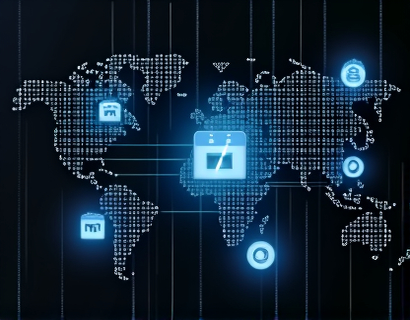Blockchain-Powered Asset Tokenization: Bridging Physical Assets with Digital Liquidity
In the evolving landscape of finance and asset management, the integration of blockchain technology stands out as a transformative force. One of the most promising applications of blockchain is asset tokenization, a process that bridges the gap between physical assets and the digital world. This innovative approach not only enhances liquidity and market accessibility but also revolutionizes the way assets are managed and traded. By leveraging the immutable and transparent nature of blockchain, asset tokenization offers a secure and efficient solution for both individuals and businesses looking to optimize their asset portfolios.
Understanding Asset Tokenization
Asset tokenization involves converting real-world assets into digital tokens on a blockchain network. These tokens represent a fraction or the entirety of the underlying asset, such as real estate, art, machinery, or even intangible assets like intellectual property. The process begins with the identification and valuation of the asset, followed by the creation of a smart contract that defines the rules and parameters of the token. This smart contract is then deployed on a blockchain, ensuring that all transactions related to the token are recorded transparently and securely.
The primary advantage of asset tokenization lies in its ability to fractionalize assets. Traditionally, high-value assets are accessible only to wealthy investors or institutions due to their significant cost. Tokenization breaks this barrier by allowing multiple parties to own portions of the asset through tokens. For instance, a piece of commercial real estate valued at $10 million can be divided into 1,000 tokens, each representing a $10,000 stake. This democratization of asset ownership opens up new investment opportunities and increases market liquidity.
Enhancing Market Liquidity
One of the most significant benefits of asset tokenization is the enhancement of market liquidity. In traditional asset markets, the process of buying and selling high-value assets can be cumbersome and time-consuming. Tokenization simplifies this process by enabling instantaneous transactions on blockchain platforms. The digital nature of tokens allows for 24/7 trading, reducing the need for intermediaries and lowering transaction costs. This increased liquidity attracts a broader range of investors, including retail investors who might otherwise be excluded from the market due to high entry barriers.
Moreover, the transparency provided by blockchain technology ensures that all transaction details are publicly visible and verifiable. This level of transparency builds trust among market participants, further boosting liquidity. Investors can monitor the performance of their tokenized assets in real-time, making informed decisions and adjusting their portfolios as needed. The reduced friction in buying and selling assets also leads to higher trading volumes, which in turn drives market efficiency and price discovery.
Improving Market Accessibility
Asset tokenization significantly improves market accessibility by lowering the barriers to entry for potential investors. Traditional asset investments often require substantial capital and a deep understanding of complex financial instruments. Tokenization simplifies this process by breaking down assets into smaller, more manageable units. This makes it possible for a wider range of investors, including those with limited capital, to participate in the market.
For example, an individual with a budget of $1,000 can invest in a tokenized real estate portfolio that would otherwise be out of reach. This accessibility not only diversifies investment portfolios but also fosters financial inclusion. By providing more people with the opportunity to invest in a variety of assets, tokenization helps to level the playing field and promotes a more equitable financial ecosystem.
Security and Trust in Tokenized Assets
Security is a paramount concern in any financial transaction, and asset tokenization addresses this through the inherent properties of blockchain technology. Once a token is created and deployed on a blockchain, it becomes immutable, meaning it cannot be altered or tampered with. This immutability ensures the integrity of the asset and the transactions associated with it. Smart contracts, which govern the rules of token ownership and transfer, are self-executing and enforceable, reducing the risk of fraud and disputes.
Furthermore, the decentralized nature of blockchain eliminates the need for central authorities, such as banks or brokers, to facilitate transactions. This reduces the risk of centralized points of failure and enhances the overall security of the system. Investors can have confidence that their assets are safe and that transactions are conducted transparently and fairly.
Use Cases of Asset Tokenization
The applications of asset tokenization are diverse and span multiple industries. Here are some notable use cases:
- Real Estate: Tokenization of real estate assets allows for fractional ownership, making it possible for multiple investors to own parts of a property. This model can also facilitate easier and faster transactions, such as rentals and partial sales.
- Art and Collectibles: High-value art pieces can be tokenized, enabling collectors to own fractions of a piece and artists to monetize their work more effectively. This also opens up new markets for digital art and NFTs (Non-Fungible Tokens).
- Intellectual Property: Creators can tokenize their intellectual property, such as patents, copyrights, and trademarks, to manage rights and royalties more efficiently. This ensures that creators receive fair compensation for their work.
- Supply Chain Management: Tokenization can enhance transparency and traceability in supply chains by tracking the ownership and movement of physical assets. This helps in verifying authenticity, reducing counterfeiting, and optimizing logistics.
- Commodities: Commodities like gold, oil, and agricultural products can be tokenized to create liquid markets and improve price discovery. This benefits producers and consumers by providing more stable and transparent pricing.
These use cases demonstrate the versatility and potential impact of asset tokenization across various sectors. By leveraging blockchain technology, industries can streamline processes, reduce costs, and create new revenue streams.
Challenges and Considerations
While asset tokenization offers numerous benefits, it also comes with its own set of challenges and considerations. One of the primary concerns is regulatory compliance. The legal framework surrounding digital assets and blockchain technology is still evolving, and different jurisdictions have varying regulations. Asset tokenizers must navigate these regulations to ensure compliance and avoid legal pitfalls.
Another challenge is the technical complexity involved in creating and managing tokenized assets. Developing robust smart contracts and ensuring the security of blockchain networks require specialized knowledge and expertise. Organizations must invest in skilled professionals and advanced technologies to overcome these technical hurdles.
Market education is also crucial. Many potential investors are still unfamiliar with blockchain and tokenized assets, which can hinder adoption. Educating the market about the benefits and functionalities of asset tokenization is essential for widespread acceptance and growth.
Future Prospects
The future of asset tokenization looks promising, with ongoing advancements in blockchain technology and increasing regulatory clarity. As more institutions and industries adopt tokenization, the ecosystem is expected to mature and expand. Here are some key trends to watch:
- Increased Institutional Adoption: Large financial institutions and investment firms are beginning to explore asset tokenization, bringing more capital and credibility to the space.
- Interoperability Solutions: Efforts to create interoperable blockchain platforms will enable seamless interaction between different tokenized assets, enhancing market efficiency and user experience.
- Regulatory Frameworks: As the market grows, more comprehensive and clear regulatory frameworks will emerge, providing a stable environment for tokenized assets.
- Innovative Token Models: New token models and structures will be developed to cater to specific asset types and use cases, further expanding the potential of asset tokenization.
These developments will continue to drive the adoption of asset tokenization, making it an integral part of the financial landscape. As the technology matures, it will unlock even more value and opportunities for investors and asset holders.
Conclusion
Asset tokenization represents a groundbreaking evolution in the way we manage and trade real-world assets. By leveraging blockchain technology, this approach enhances liquidity, improves market accessibility, and ensures security and transparency. While challenges remain, the potential benefits and future prospects make asset tokenization a compelling opportunity for the financial industry. As more entities embrace this innovative solution, we can expect a more dynamic, inclusive, and efficient market for asset investment and management.










































